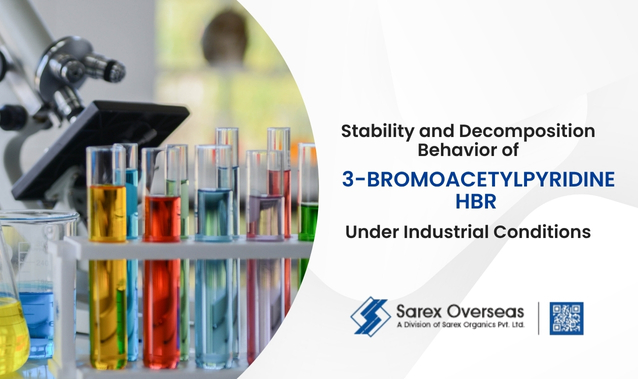3-Bromoacetylpyridine HBr, also referred to as 2-bromo-1-(3-pyridinyl)ethanone hydrobromide, is among the industrial organic chemicals becoming significant for fine chemical applications. The organic compound, which bears the CAS No. 17694-68-7 and molecular weight of 281.00, appears as an off-white or light brown needle-like crystalline solid. The product features a high level of assay not less than 98% as well as a melting range of between 188 °C and 197 °C. Though classified as a non-hazardous substance, the substance acts as an irritant and its stability also largely depends on the process as well as the condition of storage.
The core of this argument lies in the aspect whereby the compound 3-Bromoacetylpyridine HBr is stable when the situation is controlled but begins to decompose when heat, moisture, light, or incompatible chemicals come into contact with the compound.
Factors Affecting Stability
- Heat exposure and temperature are the leading causes. The compound does not change structure at ambient temperatures, but fragmentation is induced by heating almost up to the melting point. In bulk industrial processes or drying steps, heat stress of this type may reduce purity and induce impurities up to unacceptable levels.
- Moisture sensitivity. Even a few percent of water can trigger hydrolysis, culminating in cleavage of the compound with the production of unwanted side products. This necessitates the use of moisture-tight packaging and controlled humidity.
- Light exposure induces slow decomposition by photochemical actions. Direct sunlight or UV sources may provoke decomposition and need to be excluded.
Decomposition Behaviour and By-products
When it breaks down, the chemical produces a variety of poisonous products. Foremost among these products is the hydrogen bromide (HBr), a poisonous and acid-forming gas. Associates of this include the nitrogen oxides (NOₓ) from the organic segment of the nitrogen family, and the carbon oxides (CO and CO₂) from the carbon skeleton. In a limited number of cases, halogenated fumes or other poisonous vapours may also escape. These products not only affect workplace health but also reduce the quality of the industrial processes in which high-grade raw materials form a significant contribution.
Best Practices for Industrial Storage and Handling
Stability by adherence to strict best practice:
- Containers must be kept tightly closed and dry. Corrugated boxes with strip seals and double PE liners are standard.
- Store in cool, ambient temperatures, away from heat sources and from direct sunlight.
- Do not put oxidising substances or reactive chemicals close by.
- Store with desiccants or an inert atmosphere if long-term storage is intended.
- Handle in well-ventilated areas with personal protective equipment, including gloves and eye protection, as irritation could result.
Maintaining these conditions helps sustain the one-year shelf life and prevent impurities from rising above the specified maximum of 2%.
Industrial Implications
Exposure during production to heat, solvents, and reactive conditions is not uncommon. As an illustration, drying processes close to the melting point accelerate decomposition, but exposure to steam or residual oxidants during production increases impurity formation. These situations not only represent a hazard but also risk consistency of yield and product chemistry. Because industrial practice often necessitates assay levels of greater than 98%, minor decomposition may raise issues for compliance or costly reprocessing.
Trustworthy Source for Safer Industrial Application
3-Bromoacetylpyridine HBr makes a very good chemical intermediate, but stability is very dependent on careful control of environmental and process conditions. The heat, humidity, light, and incompatible chemicals can cause decomposition, which yields deleterious byproducts and lower quality. Consistent purity and safe handling demand consistent sourcing and controlled storage.
For commercial uses needing a consistent supply of 3-Bromoacetylpyridine HBr, a consistent choice comes from Sarex. Being India's first online wholesale marketplace for fine chemicals and Textile chemicals, Sarex offers bulk production as well as export support with effective quality control. Sarex provides stability, safety, as well as efficiency for all commercial uses.

